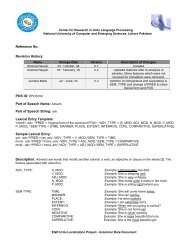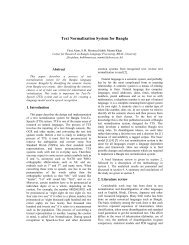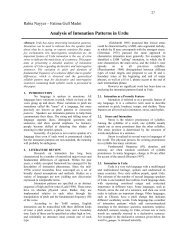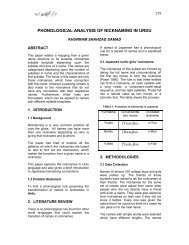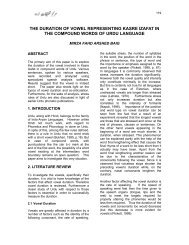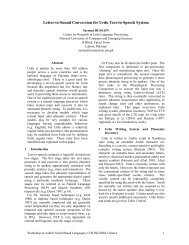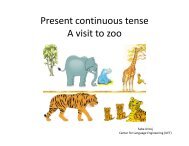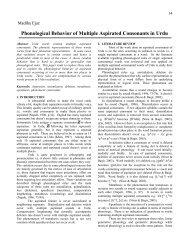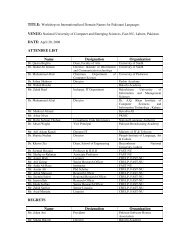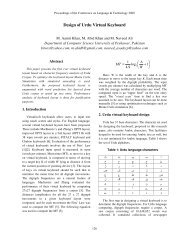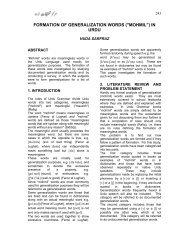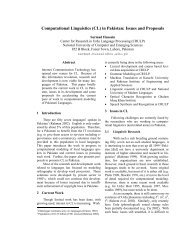- Page 2 and 3: List of Abbreviations iPolicy and P
- Page 4 and 5: Policy and Practice in AsianDistanc
- Page 6 and 7: ContentsList of TablesList of Figur
- Page 8 and 9: List of Tables1.1 The world’s twe
- Page 10 and 11: List of Figures2.1 UT’s financial
- Page 12 and 13: List of AbbreviationsAAOUACMADLAAIO
- Page 14 and 15: List of Abbreviations xiiiIGNOU Ind
- Page 16 and 17: List of Abbreviations xvUNDPUNESCOU
- Page 18 and 19: ForewordI welcome this volume, the
- Page 20 and 21: Foreword xixthen, except perhaps fo
- Page 22 and 23: PrefaceThis guidebook has been crea
- Page 24 and 25: Preface xxiii• Samtse College of
- Page 26 and 27: AcknowledgementsThe PANdora project
- Page 28 and 29: Section 1Open and Distance Learning
- Page 30 and 31: Conceptual Origins∗1Tian Belawati
- Page 32 and 33: Conceptual Origins 5students and th
- Page 34 and 35: Conceptual Origins 7industries has
- Page 36 and 37: Conceptual Origins 9• an open ent
- Page 38 and 39: Conceptual Origins 11however, focus
- Page 42 and 43: Financial Management 15Figure 2.1 U
- Page 44 and 45: Table 2.1 Cost structure of Univers
- Page 46 and 47: Financial Management 19Table 2.2 Co
- Page 48 and 49: Financial Management 21Development
- Page 50 and 51: Financial Management 23UT has never
- Page 52 and 53: Financial Management 25expenses are
- Page 54 and 55: Associations and Partnerships 27edu
- Page 56 and 57: Associations and Partnerships 29Int
- Page 58 and 59: Associations and Partnerships 31•
- Page 60 and 61: Associations and Partnerships 33AAO
- Page 62 and 63: Associations and Partnerships 35•
- Page 64 and 65: United States Distance Learning Ass
- Page 66 and 67: Section 2Evaluation and Assessment
- Page 68 and 69: Cost-effectiveness∗4Tian Belawati
- Page 70 and 71: Cost-effectiveness 43decision-makin
- Page 72 and 73: Cost-effectiveness 45Figure 4.2 UT
- Page 74 and 75: Cost-effectiveness 47If the least-c
- Page 76 and 77: Quality Assurance∗5Tian BelawatiI
- Page 78 and 79: Quality Assurance 512. The manageme
- Page 80 and 81: Quality Assurance 53• China Centr
- Page 82 and 83: Quality Assurance 55services to stu
- Page 84 and 85: Quality Assurance 579. Continual ev
- Page 86 and 87: Quality Assurance 59with us”. The
- Page 88 and 89: Student Assessment 61weaknesses are
- Page 90 and 91:
Student Assessment 63ROLE OF MARKED
- Page 92 and 93:
Student Assessment 65A major issue
- Page 94 and 95:
Student Assessment 67The Item Banki
- Page 96 and 97:
E-assessment 69in terms of economic
- Page 98 and 99:
E-assessment 71in disciplines invol
- Page 100 and 101:
E-assessment 73Social/Ethical Issue
- Page 102 and 103:
E-assessment 75consider e-assessmen
- Page 104 and 105:
Conducting and ReportingDistance Ed
- Page 106 and 107:
Conducting and Reporting Distance E
- Page 108 and 109:
7. Descriptive ScalesConducting and
- Page 110 and 111:
Conducting and Reporting Distance E
- Page 112 and 113:
Conducting and Reporting Distance E
- Page 114 and 115:
Conducting and Reporting Distance E
- Page 116 and 117:
Conducting and Reporting Distance E
- Page 118 and 119:
Section 3Media Usage in Distance Ed
- Page 120 and 121:
History of DistanceEducation Media
- Page 122 and 123:
History of Distance Education Media
- Page 124 and 125:
History of Distance Education Media
- Page 126 and 127:
History of Distance Education Media
- Page 128 and 129:
History of Distance Education Media
- Page 130 and 131:
History of Distance Education Media
- Page 132 and 133:
Print and Audio Production 105will
- Page 134 and 135:
Print and Audio Production 107instr
- Page 136 and 137:
Print and Audio Production 109scrip
- Page 138 and 139:
Print and Audio Production 111The p
- Page 140 and 141:
TV/Video Production11Dewi PadmoINTR
- Page 142 and 143:
TV/Video Production 1151. Full scri
- Page 144 and 145:
TV/Video Production 1171. Single-co
- Page 146 and 147:
TV/Video Production 119• Assistan
- Page 148 and 149:
TV/Video Production 121Table 11.3 S
- Page 150 and 151:
Online Learning Management Systems
- Page 152 and 153:
Online Learning Management Systems
- Page 154 and 155:
Online Learning Management Systems
- Page 156 and 157:
Online Learning Management Systems
- Page 158 and 159:
Figure 12.4 Moodle display for conf
- Page 160 and 161:
Online Learning Management Systems
- Page 162 and 163:
Online Learning Management Systems
- Page 164 and 165:
Production of SMS Materials 137of t
- Page 166 and 167:
Production of SMS Materials 139d) I
- Page 168 and 169:
Production of SMS Materials 141 (fo
- Page 170 and 171:
Production of SMS Materials 143requ
- Page 172 and 173:
Production of SMS Materials 145Mess
- Page 174 and 175:
Section 4Principles of Distance Edu
- Page 176 and 177:
Accessibility and Selectionof Dista
- Page 178 and 179:
Accessibility and Selection of Dist
- Page 180 and 181:
Accessibility and Selection of Dist
- Page 182 and 183:
Accessibility and Selection of Dist
- Page 184 and 185:
Adult Learning and Instructional De
- Page 186 and 187:
Adult Learning and Instructional De
- Page 188 and 189:
Adult Learning and Instructional De
- Page 190 and 191:
Figure 15.3 The systems modelRevise
- Page 192 and 193:
Adult Learning and Instructional De
- Page 194 and 195:
Course MaterialDevelopment Strategi
- Page 196 and 197:
Course Material Development Strateg
- Page 198 and 199:
Course Material Development Strateg
- Page 200 and 201:
Box 16.1 The three phases of course
- Page 202 and 203:
Course Material Development Strateg
- Page 204 and 205:
Course Material Development Strateg
- Page 206 and 207:
Course Material Development Strateg
- Page 208 and 209:
Gender and Outcome Mapping 181Figur
- Page 210 and 211:
2. Outcome and Performance Monitori
- Page 212 and 213:
Gender and Outcome Mapping 185for e
- Page 214 and 215:
Gender and Outcome Mapping 187persp
- Page 216 and 217:
Gender and Outcome Mapping 189the p
- Page 218 and 219:
Gender and Outcome Mapping 191activ
- Page 220 and 221:
Section 5Examples of Distance Educa
- Page 222 and 223:
China Open University(formerly Chin
- Page 224 and 225:
China Open University 197In recent
- Page 226 and 227:
China Open University 199the CCRTVU
- Page 228 and 229:
China Open University 201a unified
- Page 230 and 231:
Korea National Open University 203i
- Page 232 and 233:
Korea National Open University 205B
- Page 234 and 235:
Korea National Open University 207L
- Page 236 and 237:
Sukhothai ThammathiratOpen Universi
- Page 238 and 239:
Sukhothai Thammathirat Open Univers
- Page 240 and 241:
Sukhothai Thammathirat Open Univers
- Page 242 and 243:
Sukhothai Thammathirat Open Univers
- Page 244 and 245:
Sukhothai Thammathirat Open Univers
- Page 246 and 247:
Universitas Terbuka 219lack the opp
- Page 248 and 249:
Universitas Terbuka 221Most importa
- Page 250 and 251:
Universitas Terbuka 223learning mod
- Page 252 and 253:
Virtual University ofPakistan22Nave
- Page 254 and 255:
Virtual University of Pakistan 227T
- Page 256 and 257:
Virtual University of Pakistan 229a
- Page 258 and 259:
Wawasan Open University,Malaysia23G
- Page 260 and 261:
Wawasan Open University, Malaysia 2
- Page 262 and 263:
30. Multimedia Technology31. Teleco
- Page 264 and 265:
Wawasan Open University, Malaysia 2
- Page 266 and 267:
Wawasan Open University, Malaysia 2
- Page 268 and 269:
ReferencesAlexander, B. (2004) Goin
- Page 270 and 271:
References 243China Statistical Yea
- Page 272 and 273:
References 245and projects. Retriev
- Page 274 and 275:
References 247PANl10n.net (2007) PA
- Page 276 and 277:
References 249Shimizu, Y. (2006) De
- Page 278 and 279:
About the Editors andContributorsEd
- Page 280 and 281:
Indexabsorption capacity, of educat
- Page 282 and 283:
Index 255software and operational s
- Page 284 and 285:
Index 257cofirming user account, 12
- Page 286 and 287:
Index 259assignment marking in, 63-



